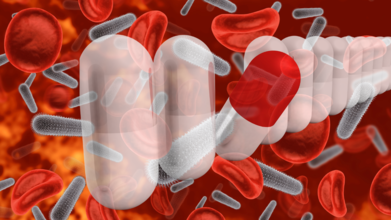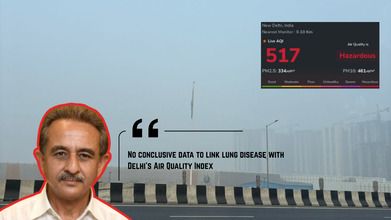- Health Conditions A-Z
- Health & Wellness
- Nutrition
- Fitness
- Health News
- Ayurveda
- Videos
- Medicine A-Z
- Parenting
AI Creates Antibiotics That Could Defeat Drug-Resistant Bacterial Infections

Credits: Health and me
The global public health community faces a growing crisis as antimicrobial resistance (AMR) continues to make common antibiotics useless, leading to more than one million deaths annually. To address this, scientists at the Massachusetts Institute of Technology (MIT) have used artificial intelligence to create two new antibiotics, NG1 and DN1, which have been found to be very effective against extremely resistant bacterial pathogens, such as Neisseria gonorrhoeae (gonorrhoea) and methicillin-resistant Staphylococcus aureus (MRSA).
This breakthrough is a significant leap towards the battle against drug-resistant infections, giving hope to patients and clinicians worldwide.
Traditional methods of antibiotic development depend extensively on screening current chemical libraries for compounds capable of inhibiting bacterial growth. While this method has been successful in the past, it has its limitations in range and velocity, especially for emerging fast-evolving drug-resistant strains.
MIT researchers employed generative artificial intelligence (AI) to explore previously inaccessible chemical spaces. With two different generative AI methods—chemically reasonable mutations (CReM) and fragment-based variational autoencoder (F-VAE)—the scientists engineered more than 36 million theoretical compounds. The compounds were computationally tested for antimicrobial activity, structural originality, and synthesizability.
MIT's Termeer Professor of Medical Engineering and Science, Dr. James Collins, described: "Our research demonstrates the potential of AI from a drug design perspective. It allows us to tap into enormous chemical spaces that were inaccessible to us before, speeding up the discovery of antibiotics with completely new mechanisms of action."
The computer-aided design process screened the enormous number of molecules down to a handful of potential candidates for laboratory synthesis. In the case of N. gonorrhoeae, the researchers used a fragment-based strategy, discovering a lead chemical fragment, F1, and creating millions of derivative molecules. Following computational screening and synthesis, a top compound, NG1, was highly effective. Tests in the laboratory and mouse models verified its capability to suppress LptA, a protein required for bacterial membrane synthesis.
For S. aureus, an open-ended design strategy generated 29 million compounds, 22 of which were synthesized. Six candidates exhibited high antibacterial activity in vitro, with DN1 showing the ability to kill MRSA in a mouse skin infection model.
The import of these findings is not simply in their activity but also in their unique mechanisms. By acting on bacterial membranes in manners distinct from current antibiotics, NG1 and DN1 diminish the risk of accelerated resistance emergence, an important challenge of contemporary antimicrobial treatment.
How Does This Discovery Contribute to the Global AMR Crisis?
Antimicrobial resistance poses a mounting threat to public health. Bacteria adapt quickly, and traditional antibiotics struggle to keep up, with treatment-resistant infections becoming more difficult to treat. Gonorrhoea and MRSA are just two high-profile examples, with the former increasingly resistant to first-line treatments and the latter causing debilitating hospital-acquired infections.
By introducing AI-designed antibiotics, researchers hope to stay ahead of bacterial evolution. These drugs could form the foundation of a new generation of antimicrobials, effective even against strains that have outsmarted traditional therapies.
Implications Beyond Gonorrhoea and MRSA
While NG1 and DN1 are only at the outset of development and need to undergo major clinical testing before being available for humans, the methodology itself is a revolution in drug discovery. The same strategy using AI could be used to create antibiotics against other bacterial pathogens, and potentially solve many resistant infections.
The approach of the MIT team also points to the wider potential of computer-aided drug design, allowing researchers to explore chemical spaces too vast for regular lab screening. This would speed up the discovery of drugs not just for bacterial disease but also for viral and fungal pathogens.
What Are The Challenges?
Although promising, AI-generated antibiotics are not yet clinically deployable. NG1 and DN1 will need to be subjected to extensive testing to determine safety, effectiveness, and lack of side effects in humans. Additionally, regulatory approval procedures for new compounds can take years, with meticulous examination at each step.
Another aspect to consider is the constant war with bacteria. Although NG1 and DN1 use new mechanisms, bacteria can potentially learn countermeasures. Ongoing surveillance and repeated cycles of drug design will be necessary to keep the advantage.
What Is The Role of AI in Future Medicine?
This advance highlights the revolutionary promise of AI in medicine. Aside from antibiotics, AI is being used more and more to discover drug candidates for cancer, neurological diseases, and metabolic disease. Through molecular interactions simulated and biological activity predicted, AI can decrease by vast orders of magnitude the time and expense of taking new drugs from idea to clinical trials.
As Dr. Collins said, "AI enables us to push the boundaries of drug discovery, opening up possibilities that were unimaginable before. This is only the start of a new frontier in antimicrobial therapy and precision medicine."
Development of NG1 and DN1 is especially apt given the growing travel and globalization, which advance the speed at which drug-resistant bacteria can spread. Gonorrhoea, for example, has demonstrated escalating resistance across a number of countries, making standard treatment regimens difficult. MRSA continues to be a major cause of hospital infections, putting healthcare systems under pressure globally.
Breakthroughs such as AI-designed antibiotics may be central to preventing future crises, in addition to vaccination campaigns, hygiene practices, and judicious antibiotic use.
The MIT researchers' discovery of AI-designed antibiotics NG1 and DN1 is a fantastic milestone in the war on antimicrobial resistance. Through the use of computational strategies to scan large chemical spaces, scientists have created compounds with new mechanisms that can target drug-resistant gonorrhoea and MRSA.
Ayush Mark Explained: What Is This New Global Standard Label For Traditional Medicine?

Credits: Canva
Prime Minister Narendra Modi unveiled the Ayush Mark at the Second WHO Global Summit on Traditional Medicine on Friday. The Ayush Mark is envisioned as a global standard for quality Ayush products and services. The WHO Global Summit on Traditional Medicine was held at Bharat Mandapam from December 17 to December 19, 2025, with this year’s theme, “Restoring balance: The science and practice of health and well-being.” Speaking at the closing ceremony, PM Modi highlighted India’s rising leadership in promoting traditional medicine as an evidence-based, integrated, and people-focused part of global health systems.
Alongside the Ayush Mark, PM Modi also introduced the My Ayush Integrated Services Portal (MAISP), the central digital platform of the Ayush Grid, released a commemorative Ashwagandha postal stamp, the WHO technical report on Yoga training, and the book “From Roots to Global Reach: 11 Years of Transformation in Ayush.” He also presented the Prime Minister’s Awards for Outstanding Contribution to the Promotion and Development of Yoga, recognizing both national and international individuals and organizations for their exceptional service.
Speaking at the event, he said, “Over the past three days, experts from across the world in traditional medicine have held meaningful discussions here. I am glad India is providing a strong platform for this, and the WHO has actively participated. It is our good fortune and a matter of pride that the WHO Global Centre for Traditional Medicine has been established in Jamnagar, India. The world entrusted us with this responsibility with great confidence at the first Traditional Medicine Summit.”
What Is The Ayush Mark?
The Ayush Mark is a label issued by the Ministry of Ayush for Ayurveda, Yoga and Naturopathy, Siddha, Unani, and Homoeopathy products and services. The Ayush Mark Certification Scheme has been run by the Quality Council of India (QCI) since 2009.
Products and services carrying the Ayush Mark follow quality manufacturing practices, use standard raw materials, and undergo safety testing. The Ayush Mark and its two previous certification levels have existed for several years. The new label builds on them and aims to set a global benchmark for traditional medicine products and services. Earlier certifications included the Ayush Standard Mark and the Ayush Premium Mark.
The Ayush Standard Mark follows Good Manufacturing Practices (GMP) for Ayurvedic, Siddha, and Unani medicines under Schedule T of the Drugs and Cosmetic Rules, 1945. The Ayush Premium Mark is aligned with WHO GMP guidelines for herbal medicines.
Dr Tedros Adhanom Ghebreyesus, WHO Director-General, also attended the WHO Global Summit on Traditional Medicine. He praised PM Modi for elevating traditional medicine to a global platform. Dr Tedros commended India for turning vision into action, calling the country a global leader in transforming traditional medicine from heritage to evidence-informed practice. He highlighted landmark initiatives like the establishment of the Ministry of Ayush and the WHO Global Centre for Traditional Medicine in Jamnagar, noting these efforts have strengthened the integration of traditional medicine into health systems, research, and policy, supporting universal health coverage and sustainable development worldwide.
Global Recognition and Impact of Ayush Mark
The Ayush Mark is not just a certification but a step toward placing Indian traditional medicine on the world stage. By setting internationally recognized quality benchmarks, it aims to boost confidence among global consumers and practitioners, encouraging the adoption of Ayurveda, Yoga, Naturopathy, Siddha, Unani, and Homoeopathy products and services worldwide. This initiative reinforces India’s role in shaping evidence-based, safe, and sustainable traditional medicine practices across borders.
What Is Denmark’s Childhood Vaccination Schedule That RFK Jr. Is Considering For The U.S.?

Credits: Canva
The Trump administration is reportedly preparing to announce changes to the childhood immunisation schedule early next year, with a proposal that would recommend fewer vaccines and bring U.S. policy closer to Denmark’s model. A source familiar with the discussions told NewsNation correspondent Libbey Dean that the revised schedule, expected next year, would involve fewer shots and would be “more in line with Denmark’s vaccination schedule,” according to The Hill. This has raised an important question: what does Denmark’s vaccine schedule look like, and is it realistic for the U.S. to follow it?
Denmark Vaccine Schedule: What Is It?
Denmark runs a clearly defined childhood vaccination programme that is free and voluntary, aimed at protecting children from serious infectious diseases. Infants are given combination vaccines that cover diphtheria, tetanus, whooping cough, polio, and Haemophilus influenzae type b, along with the pneumococcal vaccine, at 3, 5, and 12 months. Children receive their first dose of the measles, mumps, and rubella (MMR) vaccine at 15 months, with a second dose at 4 years.
A booster shot for diphtheria, tetanus, whooping cough, and polio is administered at 5 years. Around the age of 12, both boys and girls are offered the HPV vaccine to reduce the risk of cancers linked to the virus. Vaccines for chickenpox, rotavirus, hepatitis A, or meningococcal disease are not routinely included in Denmark’s standard schedule, according to official guidance from the Danish Health Authority’s Childhood Vaccination Programme.
RFK Jr. Is Considering Denmark Vaccine Schedule For US
Reports suggest that the Department of Health and Human Services (HHS) is exploring additional changes to federal childhood vaccine recommendations, with a focus on aligning them more closely with those followed by other developed nations, especially Denmark, as per The Washington Post. This discussion comes after a meeting earlier this month of the CDC’s Advisory Committee on Immunization Practices (ACIP), where childhood vaccine schedules in the U.S. and Denmark were reviewed and adjustments to the U.S. schedule were made. It was followed by a memorandum from President Trump directing HHS to begin a “process to align U.S. core childhood vaccine recommendations with best practices from peer, developed countries.”
Denmark Vaccine Schedule: What Happens If the US Adopts It?
If the U.S. were to adopt Denmark’s schedule in full, it would result in fewer vaccines being recommended for children up to age 18. When comparing vaccines that are universally advised in both countries, Denmark’s programme covers protection against 10 diseases, while the U.S. schedule includes vaccines for 16 diseases, following the removal of hepatitis B from universal recommendations. The additional vaccines recommended in the U.S. address respiratory syncytial virus (RSV), rotavirus, varicella, hepatitis A, and meningococcal disease. Although the U.S. advises more childhood vaccines than many comparable countries, Denmark stands out for recommending fewer than most. Data from the European Centre for Disease Prevention and Control (ECDC) vaccine scheduler shows that none of the other 29 ECDC member countries limits its routine childhood schedule to just 10 diseases. Several countries, including Germany, Greece, Ireland, Italy, and Poland, recommend vaccines against 15 or more diseases, while Austria’s schedule covers 17 diseases, which is even more than the U.S. currently recommends.
Every country follows its own process when setting vaccine recommendations, shaped by its specific circumstances. Childhood immunisation schedules are built over years by reviewing available evidence and weighing factors such as healthcare systems, insurance coverage, public health infrastructure, and national priorities. This explains why vaccine schedules vary across countries, and so far, no developed nation has based its decisions solely on what another “peer” country does.
Importantly, Denmark’s approach is not based on a different interpretation of vaccine science or effectiveness. Instead, Danish health authorities prioritise recommending vaccines that significantly lower the risk of death or serious illness in children. For instance, while rotavirus infections do occur among children in Denmark, they rarely result in death or long-term harm in a setting with universal healthcare access, strong medical systems, and lower inequality than in the U.S. By contrast, neighbouring countries such as Norway and Finland do include the rotavirus vaccine in their routine schedules, as does the U.S., where before the vaccine was introduced, rotavirus caused an estimated 2.7 million infections each year, leading to 55,000 to 70,000 hospitalisations and 20 to 60 deaths among children under five.
'No Direct Link Between Lung Disease And Air Pollution,' Says Minister; But Studies Say Something Else

Credits: Wikimedia Commons and AQI.in
Delhi yet again woke up to a thick smog blanketed Saturday morning. The AQI stood at 380 for the city, which puts it under the 'very poor' category, as of 7am, according to the Central Pollution Control Board (CPCB). Several parts of the city also recorded with in the 'severe' limits of air pollution, with multiple stations recording AQI above 400. These areas include Anand Vihar and Sarai Kale Khan recorded 428 AQI, ITO recorded 429, Akshardham recorded 420, Ashok Vihar recorded 407, and Rao Tularam Marg recorded 403.
While GRAP Stage IV is enforced in the capital to combat the pollution problem, amid this, Minister of State for Environment and Climate Change Kriti Vardhan Singh told the Rajya Sabha on Thursday that there is no direct correlation between higher Air Quality Index or AQI levels and lung diseases. He said that there is no "conclusive data" to establish such a link. However, he did say that air pollution is one of the "triggering factors" for respiratory ailments and associated diseases.
What Do Doctors And Research Say On The Link of Lung Diseases And Air Pollution
"Lung cancer is no longer a smoker’s but a breather’s disease," said Dr Arvind Kumar, chairman, Lung Transplant, Chest Surgery and Oncosurgery at Medanta, Gurugram, as reported by The Indian Express. He treated a 31-year-old patient from Ghaziabad with lung cancer, who had never smoked in her life.
"Younger non-smokers are being diagnosed. And there are as many women as men. This indicates that lung cancer is no longer a smoker’s but a breather’s disease. While we talk of particulate matter, the ambient air in the urban environment is full of carcinogenic gases. And this is emerging as a real threat to everybody," the doctor said.
Dr Shivanshu Raj Goyal, a pulmonologist and Associate Director Pulmonary Medicine at MAX Healthcare in Gurugram and Delhi, in an Instagram video said that breathing this toxic air is equivalent to smoking 20 cigarettes in a day. The doctor starts his video with a rather strong statement, "At present, no one in Delhi-NCR is a non-smoker."
The doctor also states that on an average, a person breathes around 20,000 times in a day, so it means we are inhaling the toxic air at least 20,000 times a day.
As per a 2017 study titled Pulmonary Health Effects of Air Pollution, it is clear that lung cancer could be exacerbated due to exposure to a variety of environmental air pollutants with greatest effects due to particulate matter (PM), ozone, and nitrogen oxides.
As per Action on Smoking and Health (ASH), a cigarette contains nicotine, and tar, which is composed of chemicals like benzene, benzopyrene, and the gas includes carbon monoxide, ammonia, dimethyl nitrosamine, cadmium, formaldehyde, hydrogen cyanide and acrolein. Some of these marked irritant properties are also carcinogen, meaning, it can cause cancer.
Whereas Air Pollution contains pollutants like particulate matter PM 10 and PM 2.5, ozone, nitrogen dioxide, carbon monoxide, cadmium and sulfur dioxide. Air pollution, which is often a byproduct of combustion or released from vehicle exhaust also contain formaldehyde, benzopyrene, and benzene. As per the World Health Organization (WHO), the pollutants contain carcinogens, and the outdoor air pollution is in fact classified as Group 1 carcinogen.
Read: Breathing Delhi's Toxic Air Is Like Smoking 20 Cigarettes A Day
Common Chemicals We Inhale When We Breathe Delhi's Toxic Air And When We Smoke A Cigarette
Carbon Monoxide: a poisonous, flammable gas that is colorless, odorless, tasteless, and slightly less dense than air.
Benzene: a colorless and highly flammable liquid with a sweet smell, and is partially responsible for the aroma of gasoline.
Cadmium: a soft, silvery-white metal (atomic number 48) that is toxic and naturally found in the environment, but human activities have increased its levels. It is used in products like batteries, pigments, and coatings, and exposure can occur through tobacco smoke, contaminated food, and occupational inhalation. Cadmium is a known human carcinogen that can damage the kidneys and bones.
Formaldehyde: a colorless, flammable gas with a strong odor, whose exposure could cause cancer.
Benzopyrene: a group of organic compounds known as polycyclic aromatic hydrocarbons. It is a colorless crystalline solid found in sources like cigarette smoke, coal tar and is a known carcinogen that can cause cancer and other health problems like skin rashes and bronchitis, and exposure requires medical attention for any symptoms.
© 2024 Bennett, Coleman & Company Limited

